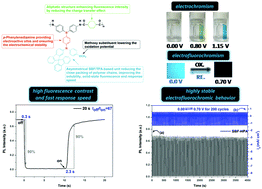High-performance blue fluorescent/electroactive polyamide bearing p-phenylenediamine and asymmetrical SBF/TPA-based units for electrochromic and electrofluorochromic multifunctional applications†
Abstract
Electrofluorochromic (EFC) materials with excellent comprehensive properties possess promising application prospects in optoelectronic and biological fields. Here, a novel high-performance polyamide (SBF-HPA) has been realized by bearing stably electroactive p-phenylenediamine and asymmetrical spirobifluorene/triphenylamine-based groups to reduce the π–π stacking of polymer chains. The resulting polyamide showed high fluorescence with a quantum yield of up to 69.7% and 14.3% for its NMP dilute solution and solid-film states, respectively. The CV curves revealed two redox couples accompanied with two stages of color change (near colorless–green–blue). Furthermore, the blue fluorescent/electroactive polyamide film exhibited excellent electrochemical stability, high fluorescence/color contrast, fast switching speed and superior EC/EFC cycling stability, facilitating real-life applications in the near future.



 Please wait while we load your content...
Please wait while we load your content...